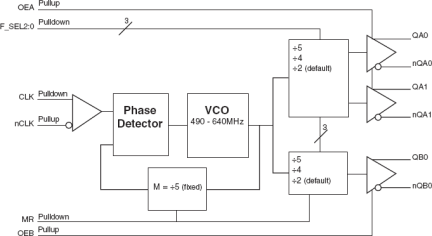概览
描述
The 874003D-02 is a high performance Differential- to-LVDS Jitter Attenuator designed for use in PCI Express® systems. In some PCI Express® systems, such as those found in desktop PCs, the PCI Express® clocks are generated from a low bandwidth, high phase noise PLL frequency synthesizer. In these systems, a jitter attenuator may be required to attenuate high frequency random and deterministic jitter components from the PLL synthesizer and from the system board. The 874003D-02 has a bandwidth of 2.1MHz. The 2.1MHz provides an intermediate bandwidth that can easily track triangular spread profiles, while providing good jitter attenuation. The 874003D-02 uses IDT's 3rd Generation FemtoClockTM PLL technology to achieve the lowest possible phase noise. The device is packaged in a 20 Lead TSSOP package, making it ideal for use in space constrained applications such as PCI Express® add-in cards.
特性
- Three Differential LVDS output pairs
- One Differential clock input
- CLK and nCLK supports the following input types: LVPECL, LVDS, LVHSTL, SSTL, HCSL
- Output frequency range: 98MHz - 320MHz
- Input frequency range: 98MHz - 128MHz
- VCO range: 490MHz - 640MHz
- Cycle-to-cycle jitter: 35ps (maximum)
- Supports PCI Express® Spread-Spectrum Clocking
- The 2.1MHz bandwidth mode allows the system designer to make jitter attenuation/tracking skew design trade-offs
- 3.3V operating supply
- 0°C to 70°C ambient operating temperature
- Available in lead-free (RoHS 6) package
产品对比
应用
文档
|
|
|
|
|---|---|---|
| 类型 | 文档标题 | 日期 |
| 数据手册 | PDF 466 KB | |
| 产品变更通告 | PDF 611 KB | |
| EOL 通告 | PDF 161 KB | |
| 产品变更通告 | PDF 611 KB | |
| 产品变更通告 | PDF 596 KB | |
| 产品变更通告 | PDF 544 KB | |
| 产品变更通告 | PDF 95 KB | |
| 产品变更通告 | PDF 50 KB | |
8 items
|
||
设计和开发
模型
ECAD 模块
点击产品选项表中的 CAD 模型链接,查找 SamacSys 中的原理图符号、PCB 焊盘布局和 3D CAD 模型。如果符号和模型不可用,可直接在 SamacSys 请求该符号或模型。

产品选项
当前筛选条件
视频和培训
This is the first video in our PCIe series. In this video, we define PCIe architectures, focusing on common and separate clock architectures. Watch the rest of the video series below where Ron will cover the impact of different timing architectures.
Watch the Video Series Below






